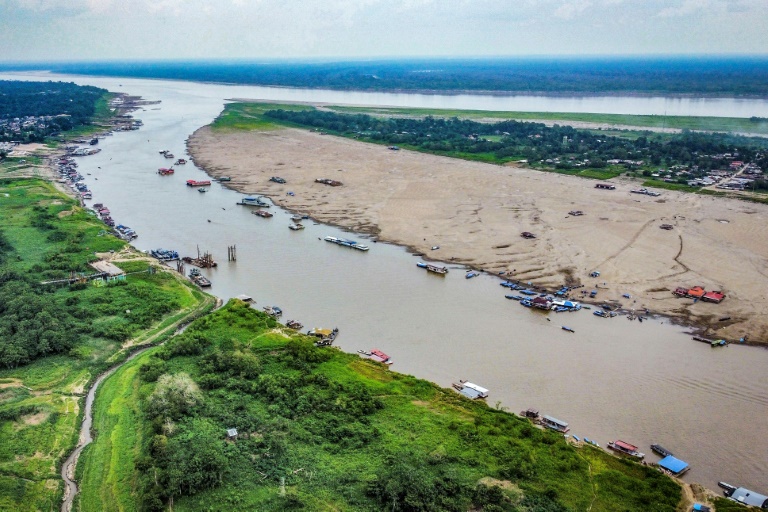Extreme drought is affecting large parts of South America and has drastically reduced the water level of the Amazon River, on the border between Colombia, Peru and Brazil, limiting food supplies and endangering the health of the inhabitants.
“The Amazon is drying up,” the mayor of the Colombian border town of Leticia, which lies on the smaller of the two branches of the river that flows through the Three Borders Area, complained to AFP.
The water level of the Amazon, the world’s largest river by volume, dropped by 10 meters in Leticia between June and August, according to Colombia’s Institute of Hydrology, Meteorology and Environmental Studies.
The receding waters have turned the riverbanks into steep earthen walls, preventing the ships that supply Leticia’s 60,000 residents with food, drinking water and fuel from docking in the city.
The water level is so low that the community has built a wooden staircase from the pier to the water.
Leticia Mayor Elquin Uni said basic goods have become scarcer and more expensive as the city is stranded.
“They are now even taking two or three months (to arrive). This has made things difficult and is endangering the quality of life and cost of living of our citizens,” he said.
In July, Leticia City Hall issued a “yellow alert” due to falling water levels.
Local indigenous leader Crispin Angarita told AFP he had not seen the Amazon in such a state of depletion for half a century and warned of the danger to people in urgent need of medical attention.
Because there is no river transport, “you have to walk four hours to reach a health center,” he said.
According to Peruvian media, the drought made it possible to cross the Amazon from the Peruvian town of Santa Rosa de Yavari to Leticia, while there is normally 800 meters of water between the two places.
According to Angarita, the drought also threatens the livelihoods of communities along the river, which mainly rely on the production of maize, rice, cassava and other crops.
In Brazil, the worst drought in 70 years is causing the worst forest fire season in years, affecting not only the Amazon region but also the wetlands in the southwestern Pantanal.
In Peru, President Dina Boluarte declared a state of emergency on Wednesday over deadly fires in three departments, including Amazonas, which are also linked to severe drought.
While September is normally the driest month in the Three Frontiers region, 2024 is entering dangerous new territory, said Santiago Duque of the Amazon Research Institute at the National University of Colombia.
“We have had two years of extreme drought and this time it is worse because there was less rain at the beginning of the year,” he said.
Duque blamed the situation largely on rampant deforestation in the Amazon, which in turn causes less humidity and less rainfall.
“We are destroying the Amazon gradually,” he said. “We are realizing more and more that it will never look the same again as it did in the past.”
afm/cb/mlr/bjt

